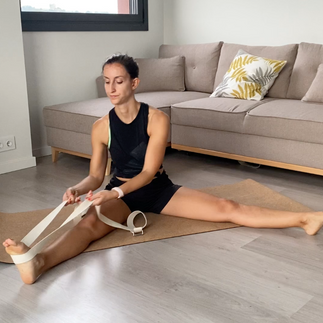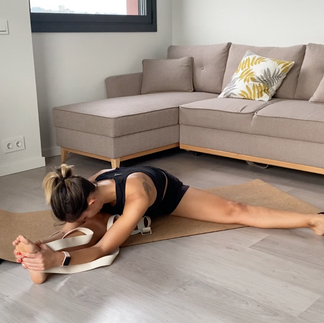Spinal Flexibility Routine to Relief Back Pain
- Zohar

- Oct 13, 2022
- 5 min read
The spine is one of the most complex parts in our body, and one of the most important. The spinal column is responsible to hold our own body structure, and support the nervous system. Therefore, if we want to live a pain free life, we need to keep our spine and back muscles healthy and happy! In today's post, we will briefly look into the anatomy of the spine, and check the flexibility and mobility exercises from the latest YouTube class, 15min of Spinal Flexibility Routine.
The spine itself is divided into 5 sections and composed with 31 pairs of spinal nerves and roots. At the same time, the spine also relies on discs, facet joints, ligaments and muscles to enable movement and stabilize our bodies. Keeping your spine flexible, well hydrated and rested is key for its health. Unfortunately, the current society's sedentary behaviours does not help our spine and back, and often it is the cause to suffer back pain.

More about Spinal Anatomy and Care: Spinal Anatomy Center
There are many measures we can take to improve the health of our spine. Getting an ergonomic chair, limiting the total sitting time and wearing shoes that support our spine are some of the most popular ways to keep our spine and back healthy and happy.
Movement is also an area that can help us improve our spine's wellbeing. Maintaining a good mobility degree in all directions of the spine (forward, backward, side, twist) together with strong core and back muscles, it will tremendously help us achieving a pain free life!
For this reason, when we stretch our back, we want to stretch it and mobilise the spine in all possible directions. Always thinking that you want to lengthen from the sacrum to the head.
Standing Roll Down or a Spinal Roll Down is a great way to start warming up and mobilising each vertebrae. Imagine you want to go down vertebrae by vertebrae, with a controlled and mindful movement. We are not aiming at reaching the floor with the hands, but creating that movement awareness that will help you connect deeper with your spine.
We can approach the Cat & Cow Stretch in the same way. We aim to connect the brain with the body, the movement itself to a deeper level by moving each vertebrae one by one. When we enter in the Cow Pose, we start by moving the sacrum. Chin up looking towards the ceiling is the very last movement we do. As we exhale and start entering in the Cat pose, first we bring the chin to the chest and push with the hands the floor away. And we follow the same logic: start rounding the cervical spine and the last part that rounds, is the sacrum (that is ends up pointing towards the floor). It sounds easy, but being able to divide the movement and the spine in sections, it is very challenging. You will need to bring extra awareness to these movements!
Cat & Cow movement is a soft version of moving the spine forwards and backwards.
The most popular backwards spine movements are Cow Pose, Cobra Pose and Up Dog. However, they are all targeting the low back's mobility. Without help and knowledge, it is very difficult to engage the thoracic spine's backwards movement in these poses. For this reason, if you would like to improve your backwards flexibility (called also back bending), you should try out the following class, solely focused on this:
Additionally, we want to move the spine to the sides. There are many side stretches we can do, like the one we do in this yoga class. But in the latest Spinal Flexibility class, we will work on opening the legs in a V shape (straddle split) and working from there with the yoga strap:
These are great exercises to stretch the QL (Quadratus Lumborum) and work on lengthening your back, while opening your hips. Use the strap during the whole exercise if needed. It is essential you keep your chest open as much as possible, and that we always lengthening from the low back. Often, people stretch rounding the thoracic spine - we want opposite. We need opposite.
We spend our days with a hunchback posture - and we do not want to end up like Quasimodo from the The Hunchback of Notre Dame, or do we?
For this reason, I always (or like 90% of the time) include the puppy stretch into the flexibility and yoga classes. It is an all round pose to open your cervical and thoracic spine, while opening your shoulders. There are many variations of it, but the one below is the classic yoga puppy pose stretch. If you keep knees and hips in one line, you will be able to target deeper your thoracic spine.

Spinal twists are also essential to ensure a healthy and happy spine. There are many variations, being the most popular:
Lay down on the back, extend one leg and bend the other leg. Extend the arms and try to keep the shoulders on the floor, while you bring the bend knee to the floor of the opposite side. In the class, we will do this exercise with eagle leg shape.
A softer spinal twist is when we lay down in our stomach, like we do it in the youtube class:

Finally, we can also mix directions: backwards with a twist, forward with a side bend, side bend and twist... there are many ways to ensure your spine stays flexible in all directions!
We will end up the YouTube class with a flow that combines all movements. In the photos below, you see how we go from the Cobra Pose to a stretch that mixes backwards, side and twist bends.
When it comes to our own health, there is no other secret than putting the work to improve our wellbeing. If you are a heavy weightlifter, or you do sports like CrossFit and never stretch, do not complain if you start suffering back pain. Many people do not make time for stretching and allowing the muscles to lengthen and rest. Then, they spend their money paying a physical therapist and massages to "fix" the issue... when in reality, if we change our habits, big part of the pain will be gone.
In the same way - speaking out of experience - if you are naturally flexible: you must strengthen and stabilize your body. Do not stretch daily, or you will weaken your muscles and ligaments.. and start experiencing pain.
Lastly, ensure you get enough sleep, have a good mattress and ergonomic chair. Drinking water is also important to ensure the health of our spine. and of course... do not forget about your daily movement!
xx
Zohar




























Comments